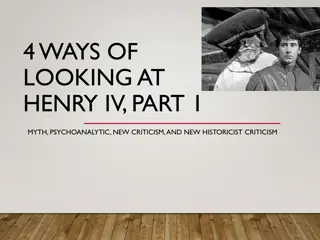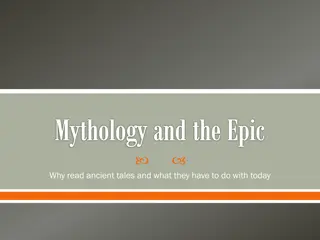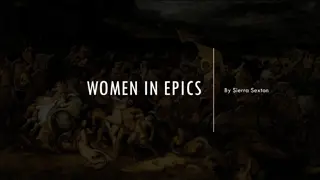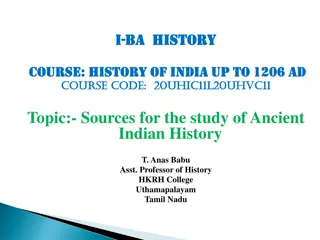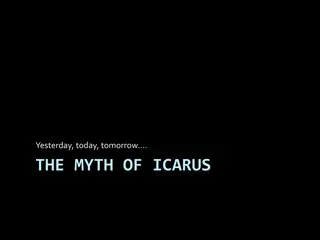Exploring the Myth of the Amazons: A Journey through Ancient Epics
Delve into the intriguing world of the Amazons, fierce female warriors of ancient Greek mythology. Uncover their portrayal in epic poems like the Iliad and the Argonautica, and follow their legendary feats in battles alongside heroes like Achilles. Discover how early historians like Herodotus situated the Amazons in diverse locations, from Pontus to Thrace, shedding light on their enigmatic existence within the Greek world.
Download Presentation

Please find below an Image/Link to download the presentation.
The content on the website is provided AS IS for your information and personal use only. It may not be sold, licensed, or shared on other websites without obtaining consent from the author. Download presentation by click this link. If you encounter any issues during the download, it is possible that the publisher has removed the file from their server.
E N D
Presentation Transcript
Amazons Based on Research of Walter Pohl Patrick Geary Salvatore Liccardo Presented by Zhou Shuhan & An Yuheng Prof.ssa Maria Christina La Rocca History of Early Middle Ages A.A. 2023/2024
Introduction: Amazons in Greek Mythology The Amazons ( ) are portrayed in a number of ancient epic poems and legends, such as the Labours of Heracles, the Argonautica and the Iliad. They were a group of female warriors and hunters who were known for their physical agility, strength, archery, riding skills, and the arts of combat. Their society was closed to men and they only raised their daughters and returned their sons to their fathers, with whom they would only socialize briefly in order to reproduce.
The Iliad (Homer, VIII Century B.C) & epic Aithiopis (c.VII Century) In one of the few references to the text of the Iliad, an Amazon force under queen Penthesilea, who was of Thracian birth, came to join the ranks of the Trojans after Hector's death and initially put the Greeks under serious pressure. Only after the greatest effort and the help of the reinvigorated hero Achilles, the Greeks eventually triumphed. Penthesilea died fighting the mighty Achilles in single combat. Homer deemed the Amazon myths to be common knowledge all over Greece. He was also convinced that the Amazons lived not at its fringes, but somewhere in or around Lycia in Asia Minor. Homer observed, the Amazons are men's equals, at least as long as they fight. But when they lie dead, they are women. As in the epic Aithiopis after Achilles has slain Penthesileia, and Thersites mocks him that he was in fact in love with her.
Observation: -The texts of the original myths didn't envisioned the homeland of the Amazons at the periphery of the then-known world, they are still well within the Greek world. -The ambiguity of the female body when it lacked the social signs normally attached to it (clothes, ornaments, make-up, etc.) would be subsided when they died, the 'wrong' signs had been removed, and the 'wrong' behaviour stopped.
Amazons as told by early historians From the time of Herodotus, Amazons were a stock element in any ethnographic account. For the early historians and ethnographers they existed on the margins not only of time but also of space: Most frequently referred to Pontus in northern Anatolia, on the southern shores of the Black Sea, as the independent Amazon kingdom where the Amazon queen resided at her capital Themiscyra, on the banks of the Thermodon river, or else in Libya, Thrace, and western Asia Minor, regions peripheral to the Greek world.
Reusing and Reshaping the Amazon Legend Despite its popularity in traditional historiography, the Amazon legend has no fixed meaning: its ambiguity and inherent contradictions keep the story alive, many texts contain traces of controversies about the subject . Also, Amazons seem to be an integral part of the account of origins of European peoples. Most prominent in Jordanes and in Cosmas Paul the Deacon's account of the Lombards Chronicle of Fredegar Bede's History of the English Church and People Adam of Bremen's account of the bishops of Hamburg other origins of medieval peoples ...
Zenobia of Palmyra(c.240-c.274) III Centry A.D Historia Augusta A third-century queen of the Palmyrene Empire in Syria. Her husband Odaenathus became king in 260, elevating Palmyra to supreme power in the Near East by defeating the Sasanian Empire of Persia and stabilizing the Roman East. In 270, Zenobia launched an invasion that brought most of the Roman East under her sway and culminated with the annexation of Egypt. In 272, in reaction to the campaign of the Roman emperor Aurelian, Zenobia declared her son emperor and assumed the title of empress, thus declaring Palmyra's secession from Rome. The Romans were victorious after heavy fighting.
Aurelian rode up to the Capitol in a chariot which had belonged to a king of the Goths and was drawn by four stags, followed by exotic animals, gladiators and captives from the barbarian tribes. Among them Arabs, Indians, Persians, Goths, Franks and Vandals. There were also led along ten women, who, fighting in male attire, had been captured among the Goths after many others had been killed; a placard declared these women to be of the people of the Amazons (de Amazonum genere) for placards are borne before all, displaying the names of their people (praelati sunt tituli gentium nomina continent es).
Among all the prizes, the most important one is Zenobia, the ruler of Palmyra and the military genius who had led the most successful separatist movement in Roman history. She destroyed the first army sent against her and finally could be defeated and conquered only by Aurelian himself. "She was a warrior who had ruled not in feminine fashion or with the ways of a woman, but surpassing in courage and skill, not merely Gallienus, than whom any girl could have ruled more successfully, but also many an emperor[...] Zenobia was ruling Palmyra and most of the East with the vigour of a man." "Now all shame is exhausted, for in the weakened state of the commonwealth things came to such a pass that, while Gallienus conducted himself in the most evil fashion, even women ruled most excellently."
Specifics -Amazons were located on the margins of the world, beyond the barbarians, where fantastic animals also lingered. -Fighting women were classed as a people of their own (Amazons), though at the same time we are told that they had been captured among the Goths. -Rome had reached bottom: the age of Gallienus was the age of sub-men and of Amazons. -Aurelian's victory over women in the east, west, and, with the Gothic Amazons, center, was in a manner consistent with his official title, Restitutor Orbis.
Observation -Regarding the Amazons as a people perceived the barbarian identities in the late Roman empire, and this otherness served to reinforce Roman self-perception. -Historia Augusta employs Zenobia in the way that early authors had used Amazons: the strength of women is the direct result of the failure of men. Their story was used to emphasize the need to reassert appropriate hierarchy. -Restitution of the world means the restitution not only of rebellious provinces of the empire and the defeat of barbarian neighbors: it also means the restitution of the proper power relations between men and women. -The Amazon myth provided a narrative matrix to accommodate fighting barbarian women, and influenced perceptions of powerful women even when they were not called Amazons. It served to express moral judgements that had little to do with those distant barbarians.
Orosius(born c. 375/385 c. 420 AD) V Centry A.D Liber Apologeticus The Amazons and Goths continued to be closely identified in the fifth century. In Liber Apologeticus, the Christian apologist Orosius understood the Amazons as Goths, he used the Amazons as an argument that the sack of Rome by the Goths in A.D. 410, had not been any worse than barbarian raids in the pagan period. The ideological potential of the Amazon myth becomes clear in such diatribes about Scythian women: O Grief! The shame of human error! Women, fleeing from their native land, entered, overran, and destroyed Europe and Asia.
However, unlike the author of the Historia augusta, Orosius breaks with the traditional use of powerful women, he didn't emphasize the failure of men to rule with appropriate strength. His presentation of the Goths of his time is of a mild, relatively pacific people compared with their Amazon ancestors. Attributing a positive role to Gallia Placidia: the sister of the Emperor Honorius captured by the Goths, in bringing about peace between the barbarians and Romans. In keeping with the polemical direction of his whole work, he connects the power of the Amazons to the blindness of paganism. The blame for the oppression of the times was nevertheless not to be imputed to the utter worthlessness of men. [...]women warriors are a thoroughly pagan phenomenon.
Observation -Christianity adapted the model of the Roman world that strong and aggressive women could be qualified as barbarian (gendered and cultural prejudices overlap) and sharpened the concepts of 'pagan' otherness. Christianisation of the Amazon myth opened up new space for its contemporary use: the shameful error of the Amazons was still possible wherever paganism reigned and men failed, for whatever reason, to control women. -"Shame of female warriors" further reinforced the ties between the stereotypes of the barbarian and the Amazon. In turn, these perceptions could be used to denounce powerful women in the Christian world, especially queens or empresses, as barbarian and shameless.
Jordanes VI Centry A.D Getica Jordanes, a 6th-century Eastern Roman historian, composing his Getica in 551-552 A.D, does not limit himself to mentioning the old saga of the Amazons but includes a large part of this narrative into the ancient history of the Goths.The identification of the Amazons with Gothic women becomes more explicit in his work. He also attemptted of integrating the history of the Scythians with his account of the Gothic past.
Amazons among the Goths Amazons among Scythians -While the Caucasus was frequently considered as the dwelling place of the Amazons. (margin of the Roman world) -Roman writers considered the Goths as descendants of the Scythians, they began to connect the tale of the Amazons with the history of the Goths. -The ancient authority, who, in the eyes of Greek and Roman intellectuals, could claim a special vicinity to the Amazons, were the Scythians and the Sarmatians. The Scythians are the husband of the Amzons -the period in which the Historia Augusta was composed, the use of the ethnonym Scythians for referring to the Goths appears to have been a widespread habit among Greek authors. -Orosius: The Goths are the husband of the Amzons. The Amazons transform from female Scythians into female Goths.
Jordanes VI Centry A.D Getica After the Gothic army had left on a military expedition, a neighboring people attempts to carry off their women. The Gothic women were drawn into battle by neighbors. They strongly resisted and defeated the enemy. Emboldened by their victory, they chose two among them, Lampeto and Marpesia, as leaders. While Lampeto remained to defend the borders of their own patria, Marpesia led her army of women to conquer Asia. Here again women worriors arise because of a vacuum of male leadership.
Observation -Didn't continue the classical tradition of using Amazons to emphasize the degeneracy of male authority in the past, nor contrasted pagan and Christian values as Orosius. -Amazons as Gothic women reappear in a wide spectrum of subsequent histories of peoples. It Supported an interpretation of the role played by the myth of the Amazons in an ethnographic context. Both the enduring popularity and the adaptability of the myth was shown.
Paul the Deacon(c.720s 13 April in 796, 797, 798, or 799 AD) VIII-IX Centry A.D Historia Langobardorum The seventh-century Origo gentis Langobardorum contains a version of the Lombard origin myth, which Paul the Deacon, in his Historia Langobardorum written before 796, included almost verbatim in his Historia Langobardorum. Its core explains how the Lombards were named. (We have already read in class) After the death of Agilmund, Gambara's grandson and first king of the Lombards, Paul the Deacon described the encounter with the Amazons as an important episode of the distant past of this gens. He reintroduced women on the battlefield in a different role, as enemies: Lamissio, the second king, must overcome the Amazons to lead his people across a river.
Paul the Deacon VIII-IX Centry A.D Historia Langobardorum The warrior women preventing the Lombards from crossing a river, but Lamissio faced and killed the strongest queen of the Amazons in an underwater fight in the river, thus gaining passage across the river. As a hero who has defeated an Amazon queen, Lamissio joins the ranks of Achilles, Herakles. After relating this Amazon legend supposed to have occurred during the migration of the Lombards, Paul voiced his doubts: From all that is known from the ancient histories it is evident that the people of the Amazons was destroyed long before this could have happened; except perhaps because the places where these deeds were reported to have taken place were not sufficiently known to the historiographers and were hardly published by any of them, it could have come about that up to those times a race of women of that kind might have maintained itself there. For I also heard some say that a people of those women exist in the innermost regions of Germania to this day.
Specifics -It was not impossible that in the timeless world of barbarians, far from civilisation and history, mythological peoples had survived. If the troublesome Amazons could not be confined to a distant past, then at least they had to be at a safe distance. Only the place had changed: instead of the steppes beyond the Black Sea it was the innermost Germania. -Fighting Lombard women initially play a positive part, but later women were reintroduced as enemies in the stories.
Observation -The reorganization of the time and place: The testimony shows the possibility to reinvent the old story, not only by changing the ethnic affiliation of the Amazons but also through altering completely its temporal and spatial coordinates. -The female origins of the Lombards are only the point of departure for a male lineage. Lombard origin myth was recognized as a symbolic expression of the transition from an archaic matriarchy to patriarchy, or from the cult of a mother goddess to a god of war. -What is extraordinary about the Lombard origin myth is the amount of female agency that the narrative implies.
Adam of Bremen(before 1050 12 October 1081/1085) 1073-1076 A.D Gesta Hammaburgensis ecclesiae pontificum (Deeds of the Bishops of Hamburg) In the Gesta there are five passages that refer to the Amazons. In Book 4, the author incorporates the Amazons into his ethnographic description of the lands and peoples of the North. Adam is in fact inclined to believe that Amazons are impregnated by monsters and, while their female offspring are beautiful women, the male become Cynocephali. Adam expresses no doubt about the existence of the dog-headed people and asserts that they were often seen in Russia as captives.
Adam of Bremen 1073-1076 A.D Gesta Hammaburgensis ecclesiae pontificum (Deeds of the Bishops of Hamburg) The Swedes, who have expelled their bishops, were in the meantime pursued by divine vengeance. First, indeed, when one of king s sons, named Anund, was sent by his father to extend his dominions, he came into the land of the women, who we think were Amazons, and he as well as his army perished there of poison which the women mingled in the springs.
Observation -Reusing and integrating classical narratives -The precise time frame -With a strong religious color -Some changes in the details: Change in weapons, they were not killed or captured, but instead won.
Cosmas of Prague(c.1045 Oct 21, 1125) XII Centry a.d Bohemian chronicle By the time that Cosmas of Prague wrote his Bohemian chronicle at the start of the twelfth century which followed the history of Bohemia and its Premysl dynasty until the year of Cosmas's death, he assumed that the Amazons had once lived in Bohemia, where they dressed, fought and hunted like men, and even founded their own city, Devin, the 'city of girls'; but Libu e, their queen, had to be removed from power to pave the way for the rule of the P emyslids.
At that time the virgins of this land came to maturity without control [sine iugo] and carried arms like Amazons and, choosing commanders for themselves, fought just like young male soldiers and penetrated into the forests to hunt in a manly way , and they did not allow themselves to be chosen by men, but they chose whom and when they wanted, and like the Scythians men and women did not wear different dress. Libu e was the youngest daughter of Crocco, who were in morals and honor deemed to be the greater and whose reputation for dispute settlement during the time without judges nor princes.
Libue was wise in council, powerful in speech, chaste in body, outstanding in morals, second to none in her concern for justice, affable to all, a glory and decoration of the female sex. But, Cosmas adds, "since no one is in every way good, this praiseworthy woman-oh sad human estate was a phitonissa, that is, a seer." She judged a case between two wealthy men justly and gave her verdict. She lay, "as is the wanton softness of women when they do not have a man whom they might fear, on her elbow on her soft and richly decorated bed." The one who lost, however, complained that it was an intolerable injury that a woman should render justice. "We know that a woman, either standing or seated on a throne understands little, so how much less must she understand lying in a bed. A bed is more suited to receiving a husband than speaking martial justice." He goes on to exclaim that it would be better for men to die than to accept female rule.
Libue, hiding her shame and anger, admitted that she was and would remain a woman. "For where there is fear, there is honor. Now you need a rector who is stronger than a woman." With this she sent them home and told them that whomever they would choose the next day as lord, she would accept as husband. The next day, she had warned the people of the dangers of having a duke: "O you unfortunate people, who do not know how to live free, and that no good person loses freedom except along with life" She extols the value of liberty; and catalogs the impositions and demands that would be made by a ruler on their sons and daughters, even on the livestock. Yet, the people persist in their demand for a duke, and she indicates to them that they will find a man in the village of Staditz on the banks of the Bila, plowing with two oxen. This man, whose name was Premysl, would be the first of the Premysl dynasty. Emissaries did as they were told, found Premysl, and brought him back to marry Libu e, assume the position of duke, and, again through her prophetic powers, identify and found the city of Prague .
Specifics -Ambivalent about Libu e: On the one hand she is the paragon of female virtue and demonstrates herself superior to the men of her time. And yet, he constantly disparages her softness, her lack of a male to control her. -Libu e, as a wielder of magical arts, is a transgressor of divine order intimately involved with kingship and royal succession. Yet she is not an altogether negative figure. She exercises occult powers with justice and in pursuit of truth. -As a competent, virtuous women, Libu e finally surrendered her power to the male, but nor is Libu e destroyed or even condemned as the Amazons in classical tradition narrative. Her power may be suspect, but she works for the good of society.
Observation -Under the positive influence of female power in the real word of the 12th century, Cosmas faced a dilemma: woman's power may not conform to the proper order of the world, but it both can be potent and can advance the cause of justice. -Libu e and the Amazons belong not to the history of the Bohemian lands but to their prehistory. Their defeat or losing power are preconditions for the start of history. -Gender the Bohemian people as feminine, the age of Libu e prefigures the future relationship between the Bohemian populace and its dukes. Without lords, societies, like women without husbands, are prey to their own weaknesses. Even the best woman must cede power to men; even the Bohemians must accept the power of their dukes.
Conclusion 1. The malleable motif in the origins of peoples: Although it firmly established as part of the prehistory of peoples, what this prehistory meant could change. Through depicting a society in which the gender hierarchy was reversed, they could either exalt or denigrate the morality of their own world, and consequently use this tale for bolstering a certain political agenda, such as criticizing weak lordship or criticizing a society that because of its failings needed stern authority.
Conclusion 2. The overlap between ethnic otherness and gender otherness Early medieval ethnic identities tended to accommodate both barbarian otherness and female otherness, and project them into the past. Defining fighting women as belonging to a distinct ethnic group and confining them to a country distant in space and time were both ways of containing them. 3. Justifing the established gender hierarchy A society in which the warrior-aristocrat became the dominant form of masculinity needed to reaffirm female virtues in symbols and token narratives. Femininity had to be redefined in relation to the new ideals of controlled violence.
Conclusion 4. Ethnic identity rooted in female origins Rewriting of the myth and the displays of female power is more likely to occur at the beginning than at the end of an origin story, or even before the beginning. But then the gender hierarchy and the proper order of the world has to be symbolically reconstituted by the expulsion, or the removal from power, of wise or warlike women. But there is no denying that the Amazons play a significant role in the account of origins of Late Antique and Early Medieval gentes. Women could play an active role in the shaping of meanings and memories, and muster intellectual support. Their role in ethnic processes should not be underestimated.





